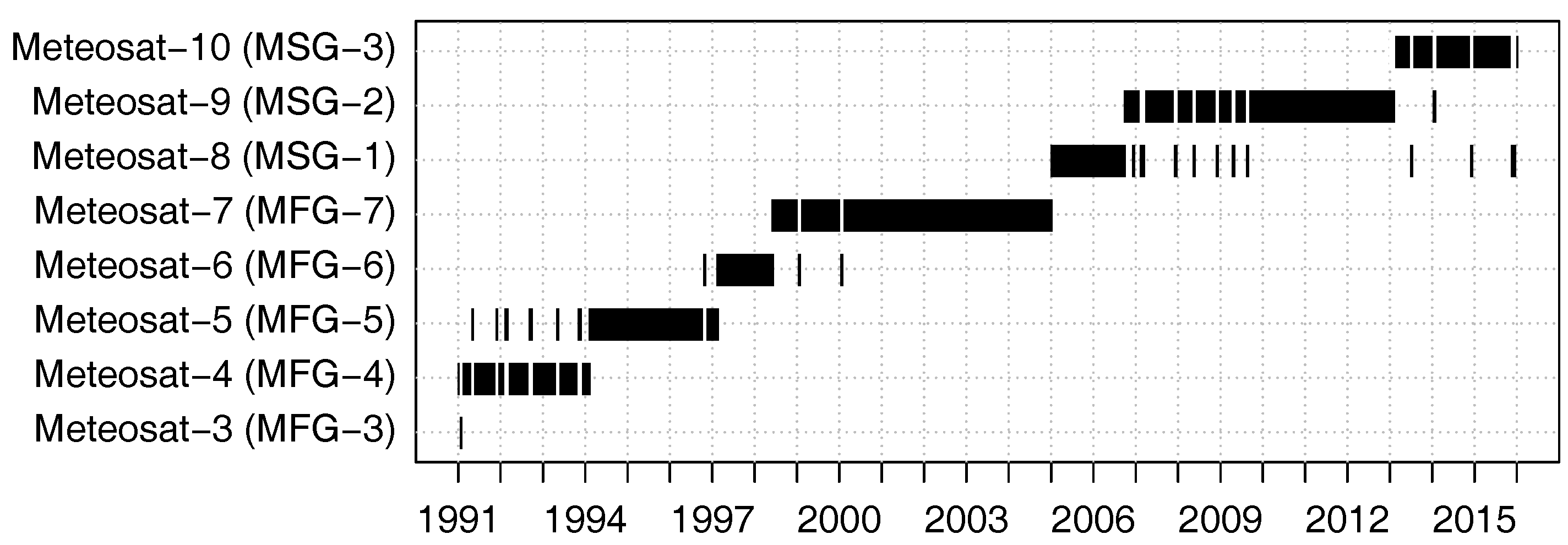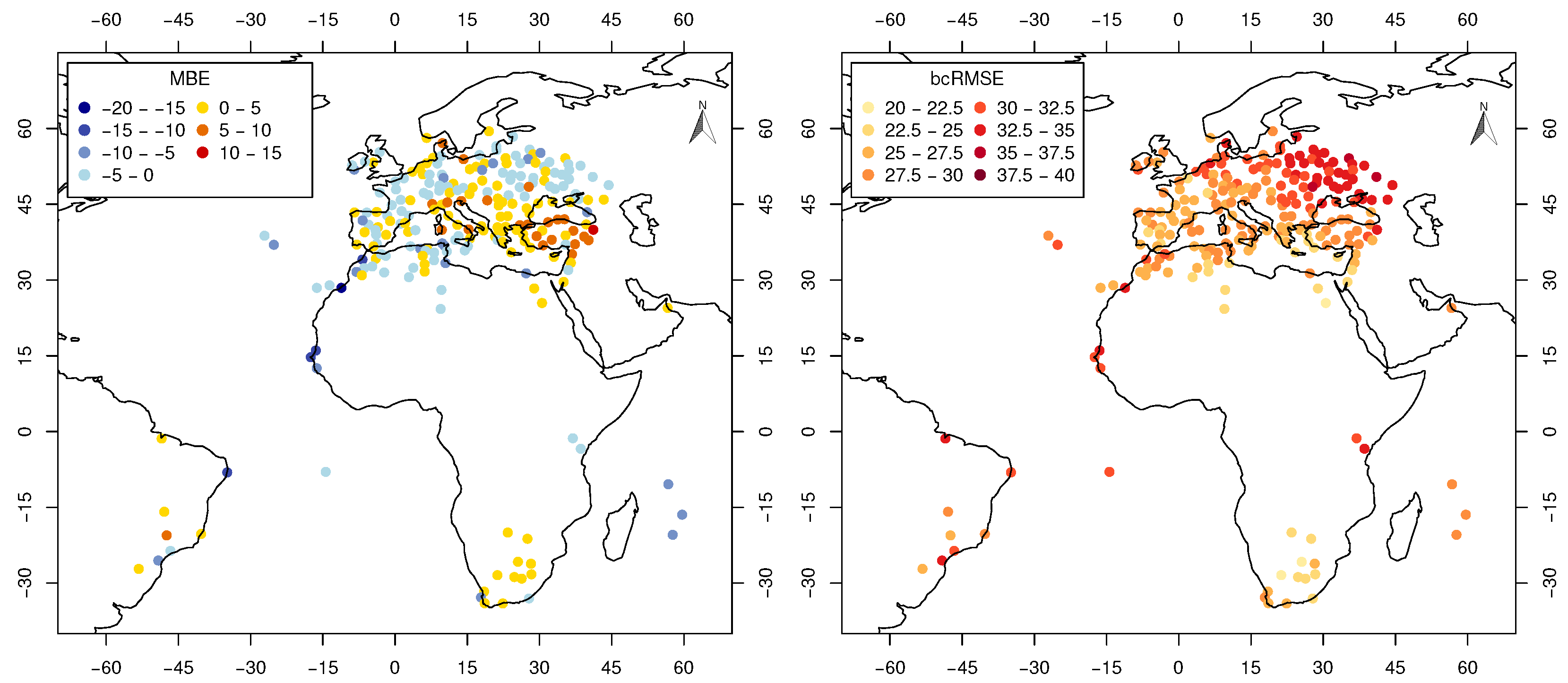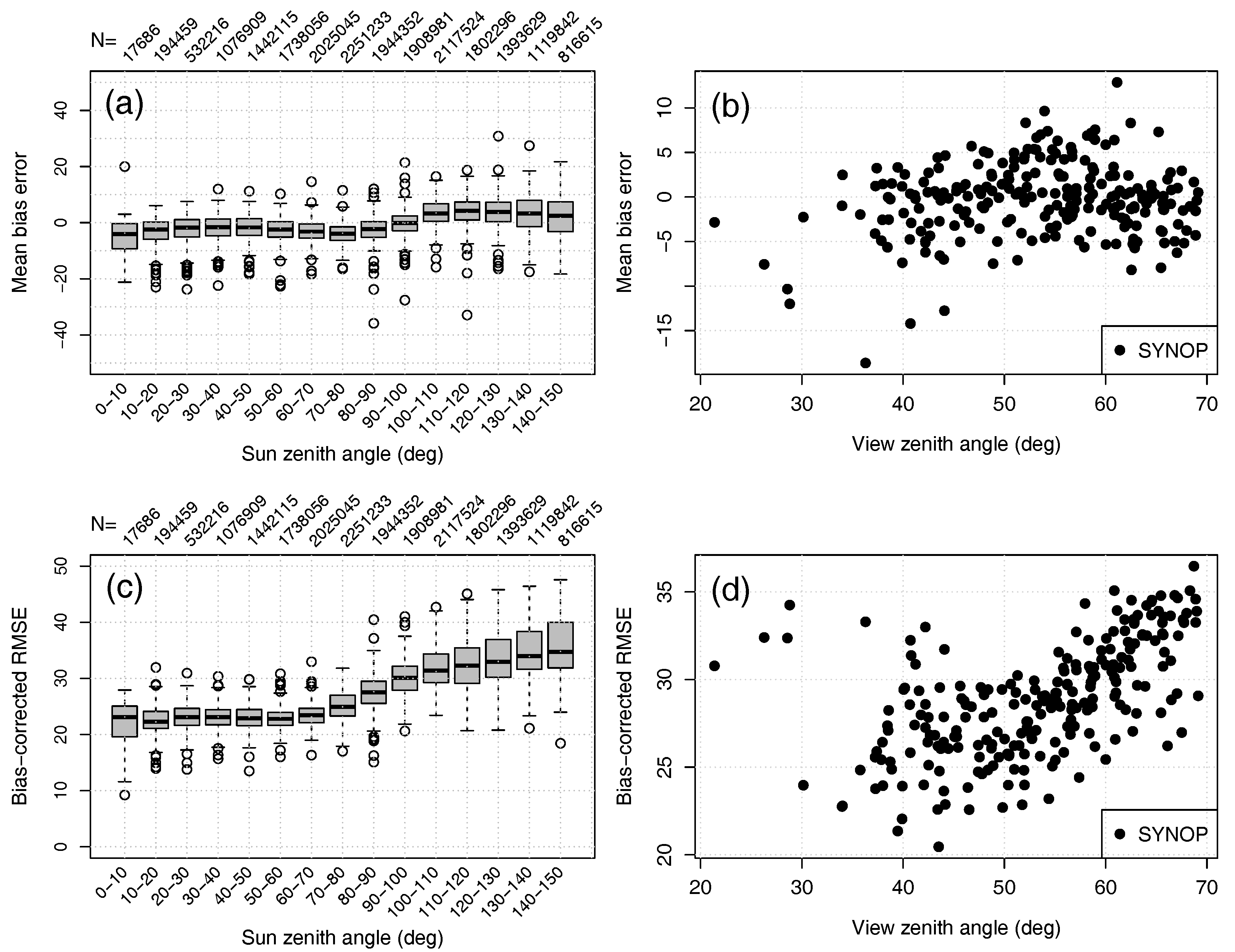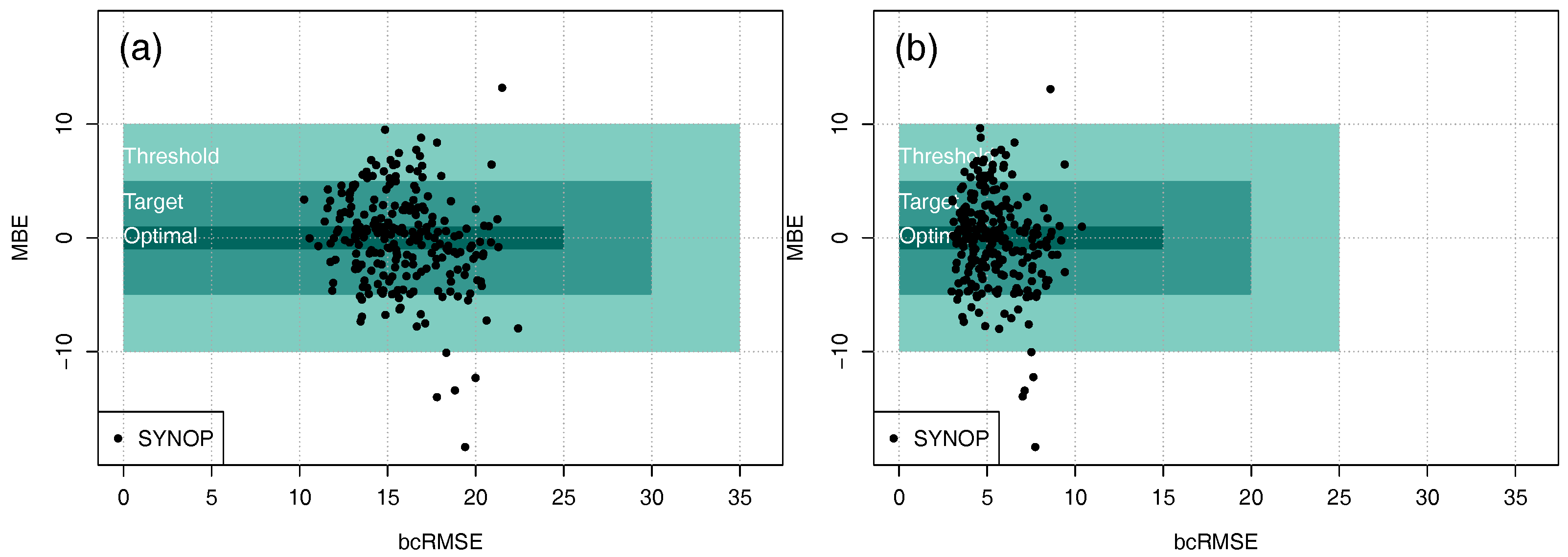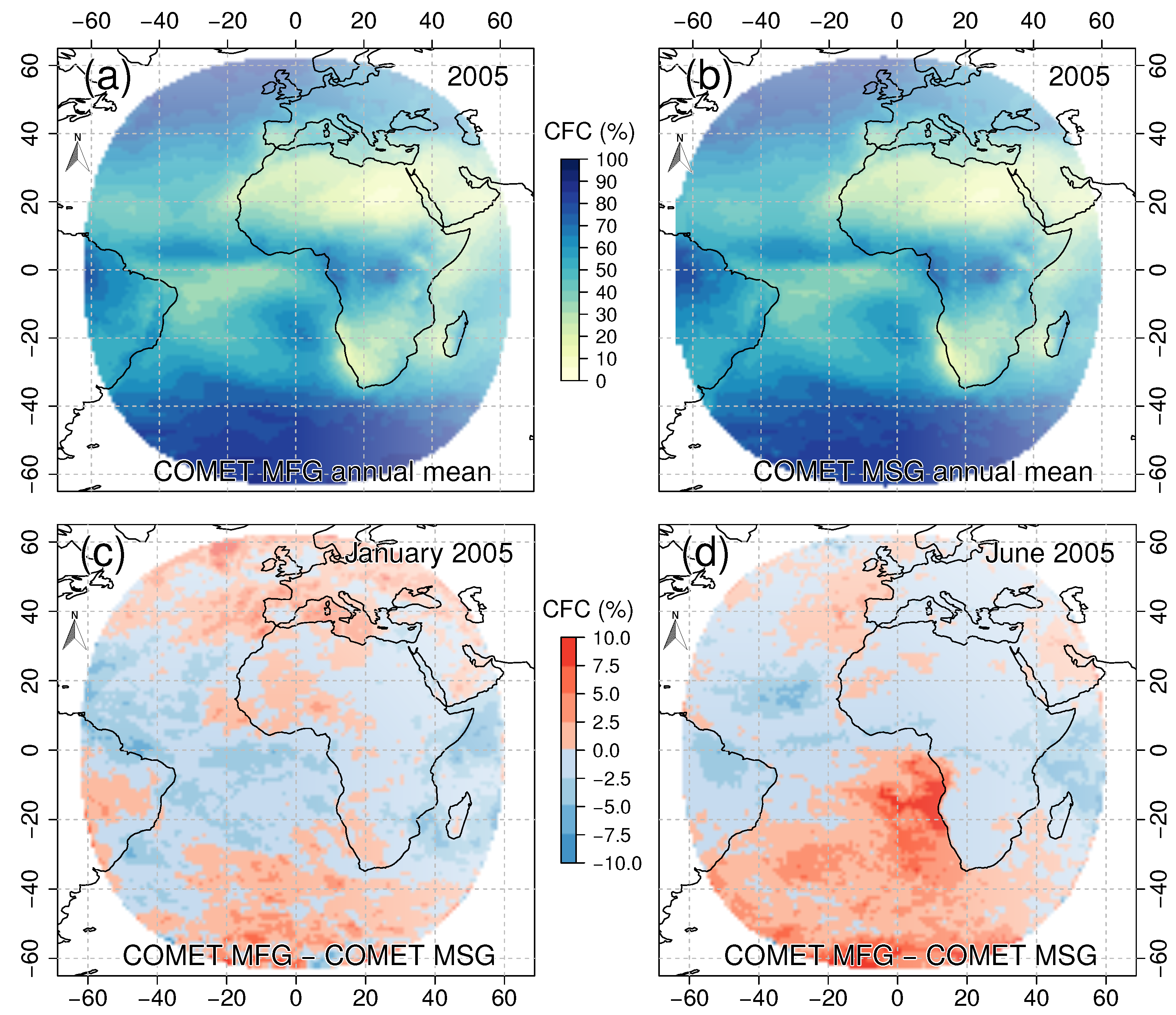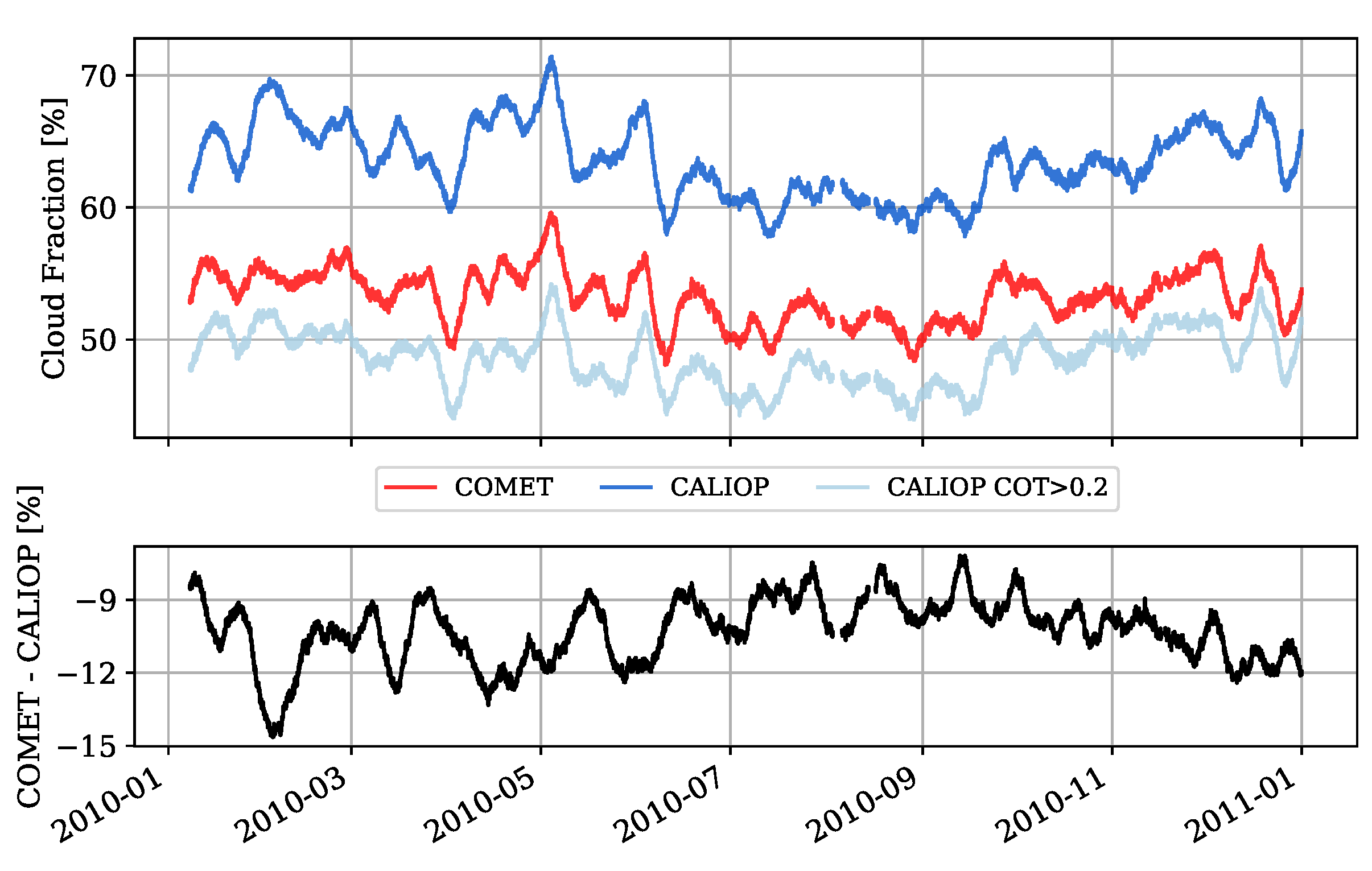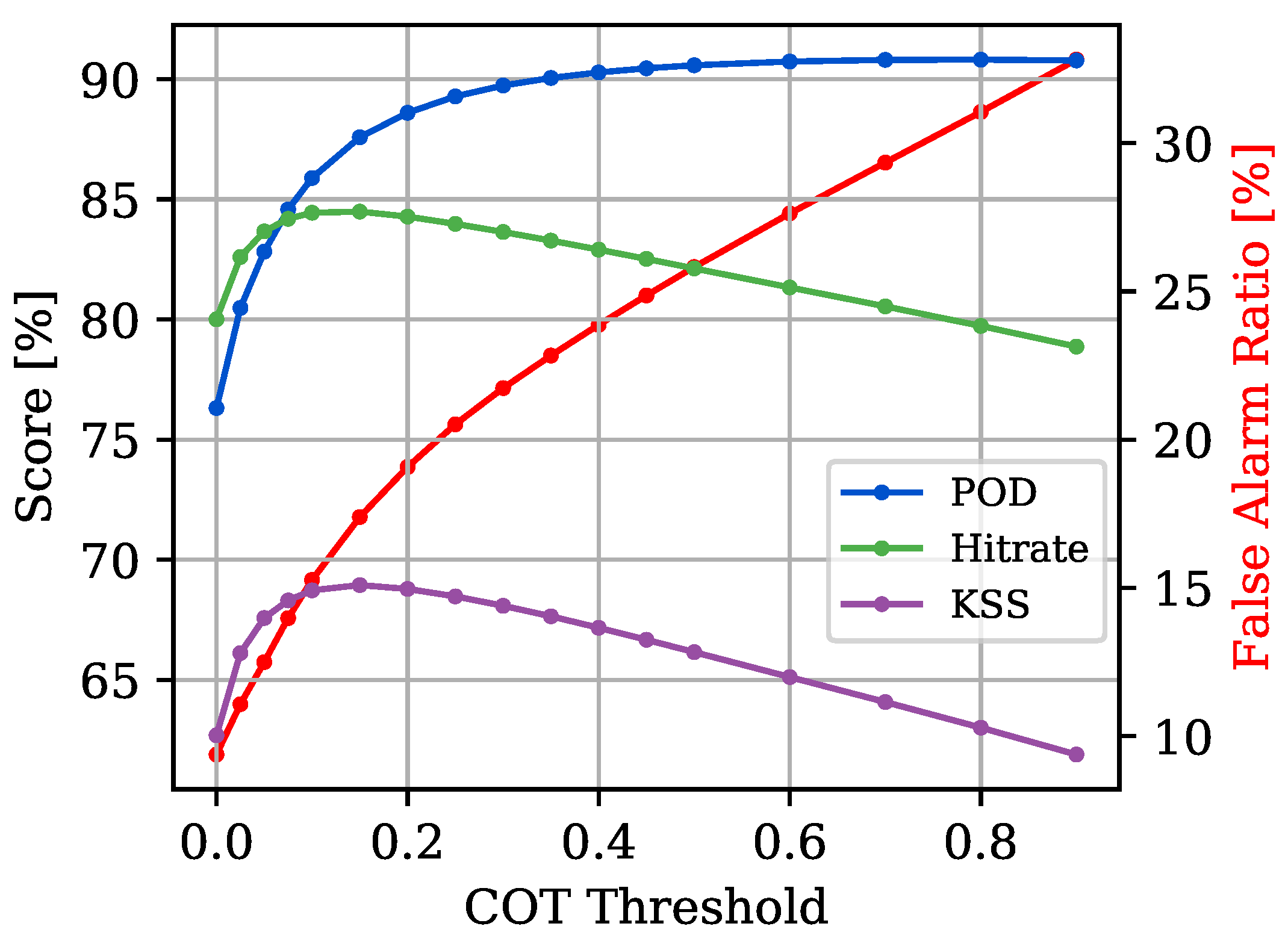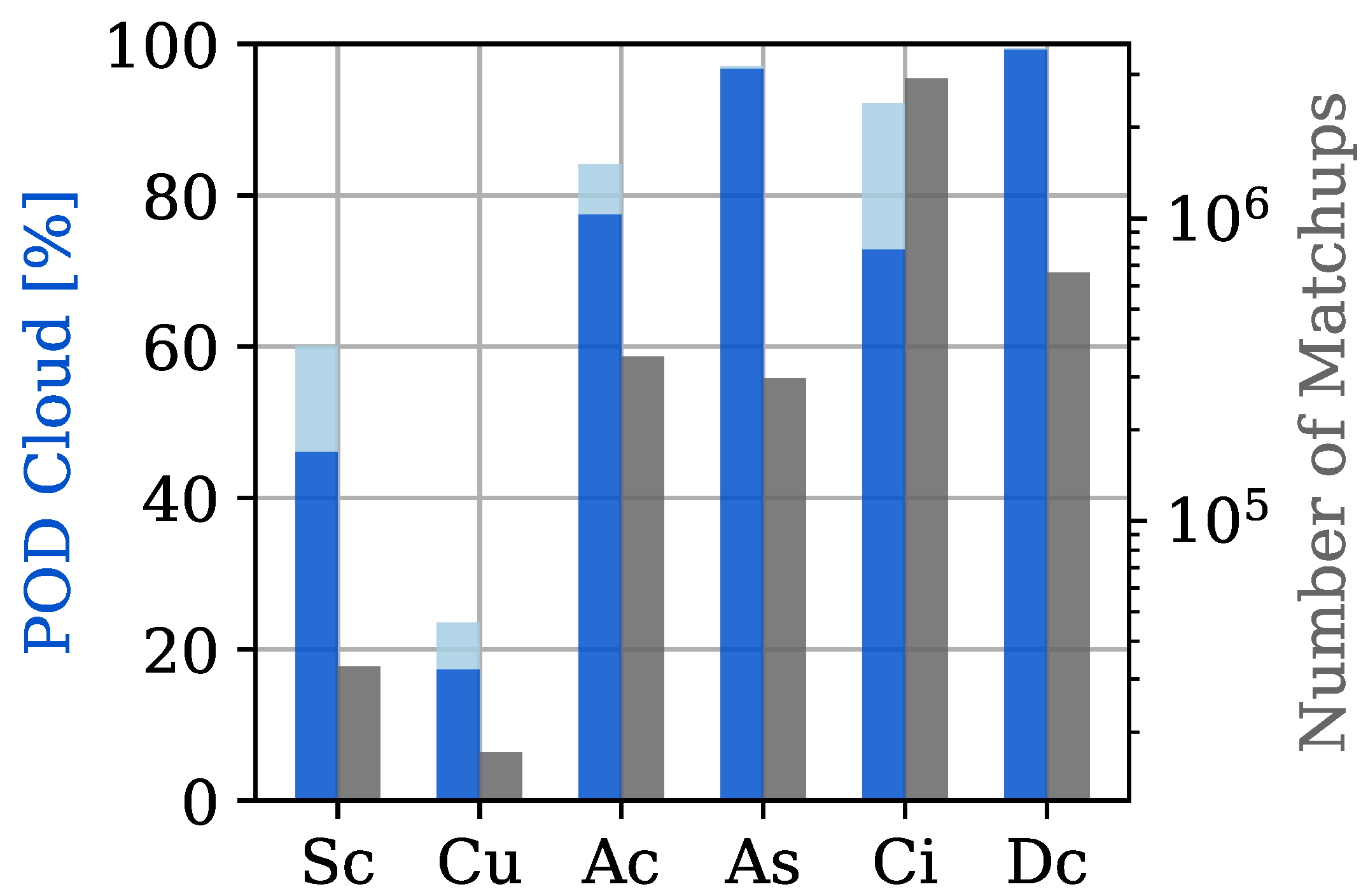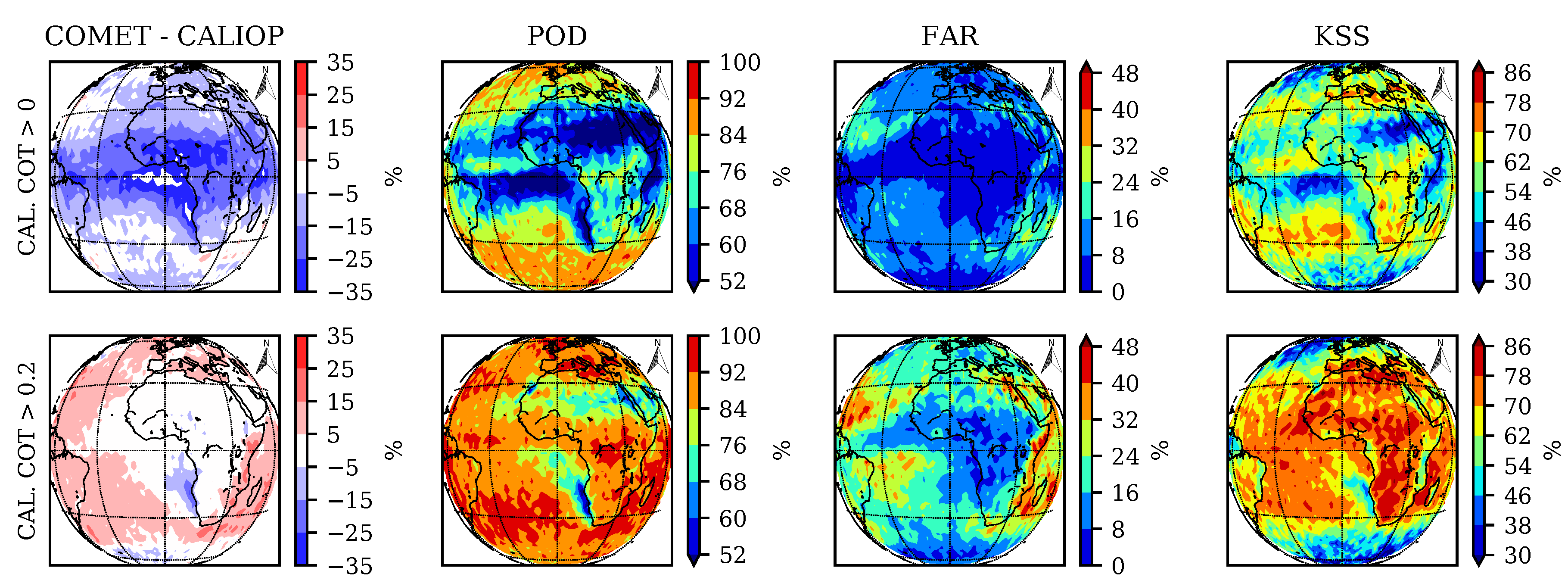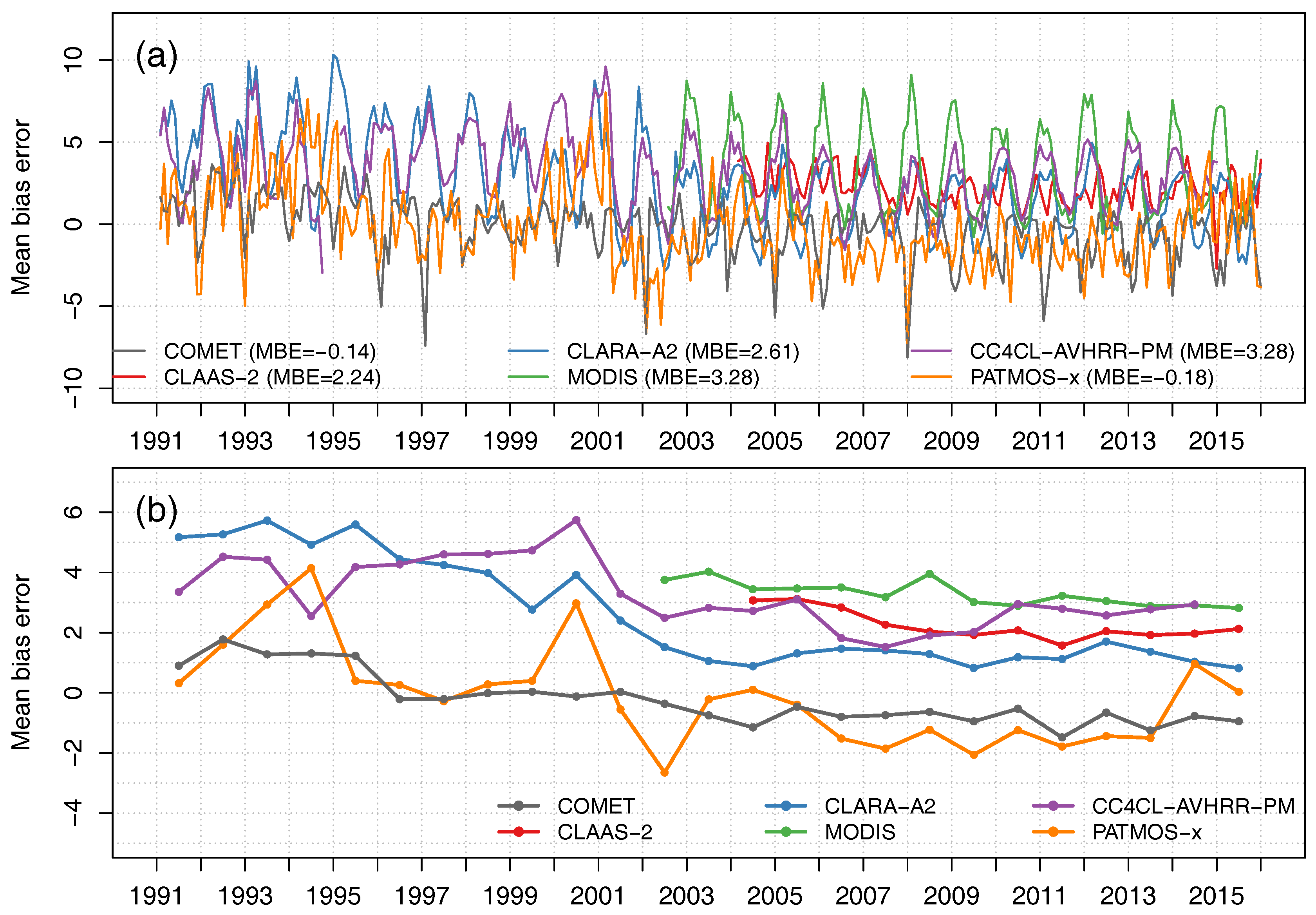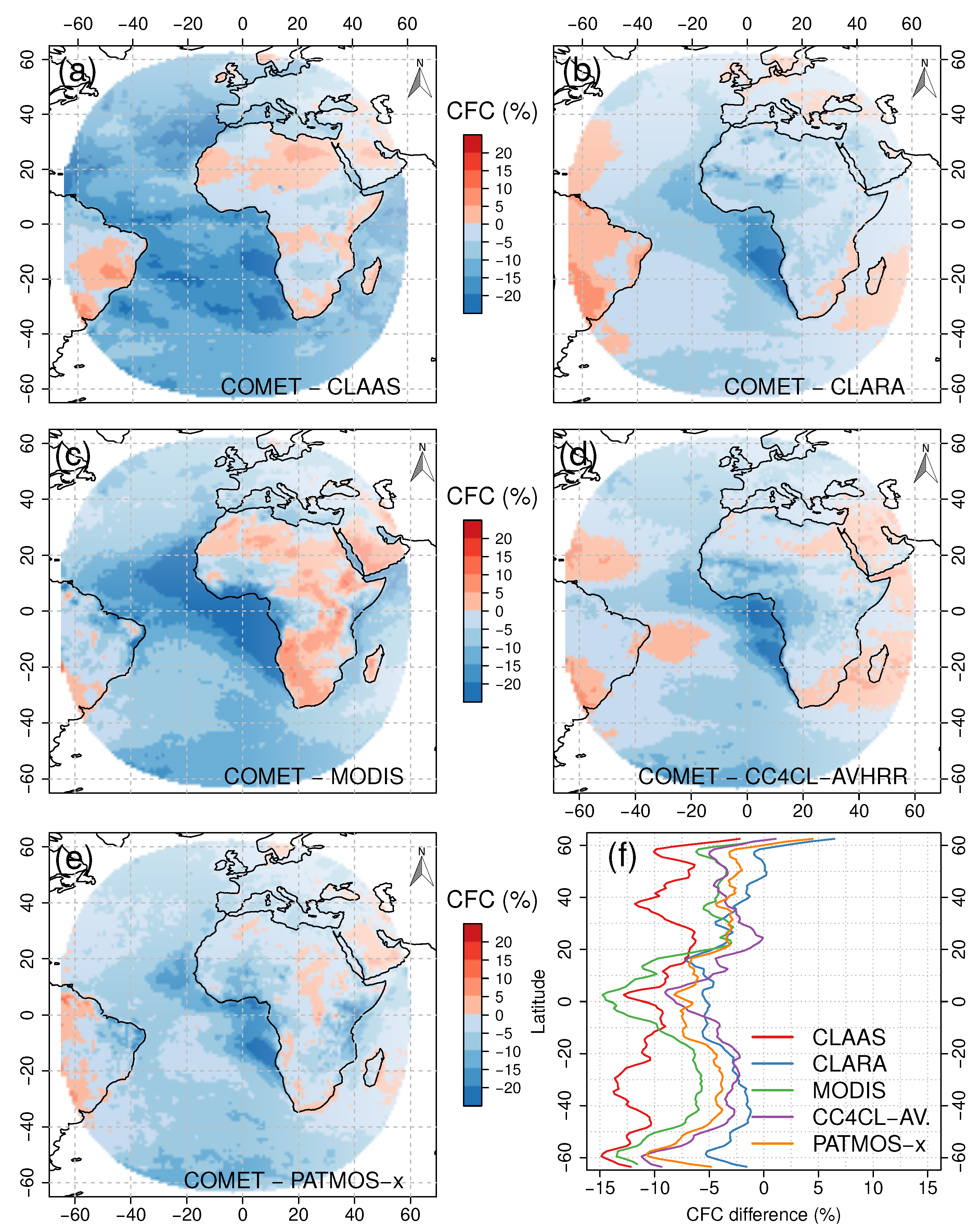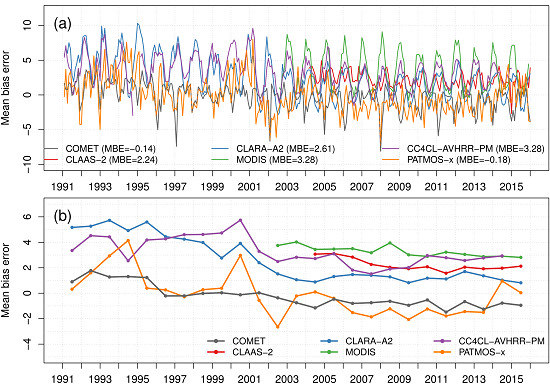1. Introduction
Clouds play a crucial role in the terrestrial climate system. They govern Earth’s energy budget and are an essential part of the water cycle [
1]. Cloud feedbacks are among the most uncertain components of the climate models [
2,
3]. Consistent and continuous cloud observations are required to better understand the cloud–climate interactions with the underlying micro- and macro-physical processes including those related to cloud-aerosol feedback. Therefore, as part of the United Nations Framework Convention on Climate Change (UNFCCC), the Global Climate Observing System (GCOS) has included clouds in the set of essential climate variables (ECVs, [
4,
5]) with a special emphasis on satellite-based retrievals [
6].
Satellites can uniquely observe changes in cloud cover on a global or regional scale. Moreover, they now span more than a 30-year period which is agreed to be a minimum to study climatological changes [
7]. Nevertheless, the climatological period can only be achieved by a limited number of satellite programs. Among polar orbiting satellites, long records were successfully built from the Advanced Very High Resolution Radiometer (AVHRR) such as International Satellite Cloud Climatology Project (ISCCP, [
7,
8]) which also employs geostationary sensors, Pathfinder Atmospheres Extended (PATMOS-x, [
9]), CLoud, Albedo and RAdiation dataset (CLARA-A2, [
10]) of the EUMETSAT Satellite Application Facility on Climate Monitoring (CM SAF), and the Community Cloud Retrieval for Climate dataset of the Cloud_cci project (CC4CL-AVHRR, [
11]) in a frame of the European Space Agency Climate Change Initiative [
12].
Producing climate data records from polar-orbiting satellites faces two particular challenges related to temporal sampling. First, polar-orbiting sensors (such as AVHRR) provide imagery for a given location at low latitudes only twice a day, from the ascending and descending nodes. For AVHRR sensors being simultaneously placed on two NOAA satellites (on morning and afternoon orbits), this leads to four observations a day. Such a temporal coverage started in 1991, while years from 1981 are covered by only two observations per day. The second challenge is related to satellite orbital drift, which is caused by Earth’s gravitation and results in shifted image acquisition times due to imperfect orbit stabilization maintained by space agencies. As a result, the cycle of diurnal cloudiness is sampled at different local times, which in turn can lead to unwanted trends detected during climatological analyses [
13]. Currently available cloud climatologies including data from geostationary satellites, such as ISCCP, are known to be hampered by temporal instabilities and view-angle effects [
14].
Therefore, CM SAF has employed data from the geostationary Meteosat satellites to produce cloud climatologies with a fully resolved diurnal cycle. Cloud physical properties were retrieved from 12 channels of the Spinning Enhanced Visible and Infrared Imager (SEVIRI) on board Meteosat Second Generation (MSG) for the Cloud Property Dataset (CLAAS), whose second version has been recently published [
15]. The data record is limited to a (non-climatological) period of 12 years (2004–2015). Meteosat observations are, however, available since 1982 if Meteosat First Generation (MFG) with its Meteosat Visible and Infrared Imager (MVIRI) is taken into account. A combination of MFG and MSG data has been used by CM SAF to produce climate data records of (1) surface radiation, sunshine duration and effective cloud albedo (SARAH-2, [
16]), (2) top-of-atmosphere short-wave and long-wave radiation [
17], and (3) free tropospheric humidity [
18].
This paper evaluates the CM SAF ClOud Fractional Cover dataset from METeosat First and Second Generation (COMET, [
19],
https://doi.org/10.5676/EUM_SAF_CM/CFC_METEOSAT/V001) derived across Meteosat generations from MVIRI and SEVIRI following a novel cloud detection methodology. The dataset features CFC available at hourly, daily and monthly means for a period 1991–2015 aggregated on a regular 0.05° × 0.05° grid. In the following, we describe the underlying satellite data (
Section 2.1) and the cloud detection algorithm (
Section 2.2), data used for validation (
Section 3) and intercomparisons (
Section 4), as well as results of validation and intercomparisons (
Section 5,
Section 6 and
Section 7). Finally, conclusions are drawn in
Section 8.
3. Validation Methods and Data
The purpose of the validation effort is to characterize COMET CFC in terms of its accuracy and precision (See
Appendix A.1), thus to give a guidance for the product applicability. Furthermore, the data record is confronted with the product user requirements collected by CM SAF [
29]. These requirements determined for three categories (
threshold,
target and
optimal) follow the definitions from the WMO Observing Systems Capability Analysis and Review Tool (OSCAR,
http://www.wmo-sat.info/oscar/observingrequirements).
The
threshold is the minimum requirement to be met to ensure that data are useful and can be provided to the user. The
target is an intermediate level that would result in a significant improvement for the targeted application. It is a realistic requirement taking into account the scientific challenges and available sensors. The
optimum is an ideal requirement above which further improvements are not necessary. The last one is the best possible requirement under optimal conditions of input and auxiliary data, available sensors and retrievals. Ideally, the optimum requirement is bound to the GCOS requirements for using the ECV in the field of climate monitoring and climate change detection. The requirements defined for COMET for these three categories are summarized in
Table 1.
Requirements on decadal stability are 5%, 2% and 1% for threshold, target and optimal classes. These requirements and the ones listed in
Table 1 are defined after taking into account requirements from different users and user groups. The most well-established reference here is the recommendations issued by GCOS [
6,
30]. However, values are also influenced by requirements from users working with regional climate monitoring and regional climate modelling applications.
3.1. Synoptic Observations
Synoptic observations from the archive of the European Centre for Medium-Range Weather Forecasts (ECMWF) were used for COMET validation. The archive contains data from over 6000 sites worldwide. From these, we selected sites: (1) within 60°N/S and 60°W/E, (2) for which the satellite viewing angle is below 70°, and (3) where observations were continuously performed in 1991–2015, at least every 6 h with a maximum break of 30 days. Further, we excluded sites with any inhomogeneity in a time series of cloud amount monthly anomalies according to Standard Normal Homogeneity Test (
Appendix A.2). Finally, since SYNOP stations are unevenly distributed in geographic space, in each 2° × 2° geographic grid cell, we selected one SYNOP site with the most frequent observations. This yielded a total of 237 SYNOP sites distributed over the full Meteosat disc. Yet, there is still a stronger bias towards European stations.
To validate COMET against SYNOP, the collocations were performed for instantaneous level-2 data. This means that exclusively COMET estimates which had corresponding synoptic observations (undertaken at the same UTC time and within a range of a given pixel) were collocated. Based on these collocations, we first assessed the performance of the instantaneous COMET CFC estimates by means of mean bias error (MBE) and bias-corrected root mean square error (bcRMSE) defined in
Appendix A.1, which are widely used by the climate modelling and cloud remote sensing communities. Further, the collocations were aggregated to daily and monthly means, and evaluated. A time series of monthly MBE was also used to analyse COMET decadal stability defined as a change (trend) of MBE over time, as well as COMET homogeneity investigated by means of the Standard Normal Homogeneity Test (
Appendix A.2).
3.2. CALIPSO-CALIOP
The Cloud–Aerosol Lidar with Orthogonal Polarization (CALIOP) on board the Cloud-Aerosol Lidar and Infrared Pathfinder Satellite Observation (CALIPSO) satellite provides detailed profile information about cloud and aerosol particles and corresponding physical parameters [
31]. This dataset is suitable for validation, as the CALIOP 532 nm signal comes from cloud, aerosols and precipitation particles and is therefore not “contaminated” by radiation emitted/reflected from the ground surface as in the case of most passive radiometers. Using a feature classification algorithm [
32], the origin (clouds, aerosol, stratospheric feature) of the backscattered signal can be determined.
The CALIOP products are available in five different resolutions with respect to the along-track resolution including 333 m (resolution based on the spacing between consecutive footprints of 70 m), 1 km, 5 km, 20 km and 80 km. We used the CALIOP Level-2 5-km cloud layer data record version 3-01 (CAL_LID_L2_05kmAPro-Prov-V3-01) since this 5-km resolution is the closest to the nominal MVIRI/SEVIRI resolution. CALIOP provides information about cloud phase and cloud type, which allowed for cloud-type-specific evaluation.
5. Validation with SYNOP
The overall difference in CFC between instantaneous COMET and SYNOP averaged over 237 sites is −0.3% except for Arid and Ocean zones, for which the bias is negative at approximately −5% (
Table 2). However, the bias at individual sites (
Figure 3, left) does not reveal distinct spatial patterns, except an overestimation of 5–15% in Anatolia. The mean COMET bcRMSE is approximately 30%; however, a noticeable decrease in precision can be seen in Europe from SW to NE (
Figure 3, right).
COMET slightly overestimates SYNOP CFC (MBE = 3%) and is less precise (bcRMSE = 34%) during night-time. It underestimates SYNOP CFC during daytime (MBE = −2.74%) but with higher precision (bcRMSE = 24%). It is confirmed by a more detailed performance assessment of COMET in dependence on sun zenith angle (
Figure 4a,c).
A seasonal cycle of COMET performance is revealed by a negative bias and larger bcRMSE during the Northern Hemisphere’s winter months (DJF), and a positive bias and lower bcRMSE in summer months (JJA) (
Table 2). The impact of seasons may be diminished, as statistics are averaged over both hemispheres; however, the greater impact of snow cover on cloud detection is expected to occur in the Northern Hemisphere.
Table 3 which presents COMET performance for the Northern Hemisphere winter months only, reveals the most prominent underestimation of CFC in Tropical areas (exceeding −10%). However, the impact of this underestimation on the overall COMET performance is limited due to a small number of synoptic observations available in the tropical zone (see
N in
Table 2). The seasonal cycle of COMET performance with larger negative bias during DJF is related to the expected major problems with cloud detection over snow-covered surfaces. The lowest precision (bcRMSE >40%) for the night-time retrieval in the Cold zone reveals a limited cloud detection capability over snow-covered surfaces, when only one thermal channel is available.
On average, at low viewing zenith angles (VZA < 30°), COMET underestimates SYNOP CFC by approximately 7% (
Table 3). This dependency is due to the very few long-term SYNOP sites in the arid zone of Africa located at a low viewing angle and is discussed later in this section. At VZA > 60 degrees, COMET loses precision (
Figure 4b,d) as expected due to high atmospheric path lengths and possibly parallax effects.
Averaged over all 237 reference SYNOP sites, COMET fulfils the optimal accuracy and precision requirements (
Table 1) for both daily and monthly means. The optimal accuracy requirements are 1% for MBE met by daily (MBE = −0.17%) and monthly (MBE = −0.14%) COMET CFC means. Similarly, bcRMSE of 16.53% and 7.04% comply with optimal precision requirements of 25% and 15% for daily and monthly means, respectively (
Table 2). Taking accuracy and precision requirements simultaneously into account—optimal, target and threshold requirements are met by 26%, 80% and 97% of sites, respectively (
Figure 5).
CFC at six sites do not comply with the threshold requirements (
Figure 5). For the SYNOP station with the WMO identifier 17,096 located in Anatolia, COMET CFC is overestimated. This is likely related to the already described general overestimation for this region (
Figure 3) and needs further analysis.
On the other hand, there are five sites where COMET underestimates SYNOP CFC by 10–20%. All five sites are located in the coastal zones of arid and oceanic environments (
Figure 3). This underestimation is consistent with
Table 2 summarizing the statistics for these environments. We hypothesize that the underestimation is related to a scale mismatch at coastal zones where the observation site is located on land and the satellite pixel covers both ocean and land. Possibly, the sharp change in background (clear-sky) reflectance and brightness temperature within a single satellite pixel might not be compatible with the current CFC algorithm where several continuous cloud scores as input to the naïve Bayesian classifier are based on difference tests between the all-sky and clear-sky reflectance fields. Eventually, the cloud cover itself has a sharp change from land to ocean, leading to a reference measurement on land which is not representative for the entire satellite pixel. These hypotheses need to be verified and taken into account in the algorithm improvements for a next release of COMET.
Decadal Stability
To assess the temporal stability of COMET, we computed MBE and bcRMSE for each month in 1991–2015 over 237 SYNOP sites. As shown by a dashed line in
Figure 6a, the trend in the bias is −0.94% per decade, thus within the optimal requirements. Note that this negative trend is related to the overestimation of SYNOP CFC before 1996, i.e., no significant trend was detected separately for years before and after 1996.
The break in the MBE time series was corroborated by the relative SNHT test which, following the guidelines of Aguilar et al. [
45] and Toreti et al. [
46], was carried out based on the de-trended mean monthly cloud fraction difference between COMET and SYNOP. At the turn of 1995 and 1996, statistic
of the relative test slightly exceeds the critical value, which for a time series of 300 elements is equal 10.02 at the 95% confidence level (see
Appendix A.2 for SNHT definition and details). The explanation for this inhomogeneity, very likely caused by non-climatic factors, is not trivial, as there was no change of satellites in that period (see
Figure 1). We intend to evaluate possible inhomogeneities in both the reference and satellite time series separately in order to better attribute the source of this inhomogeneity.
The homogeneity analysis does not reveal a break during the transfer from MFG/MVIRI to MSG/SEVIRI (2004 to 2005). Differences in COMET employing MVIRI and SEVIRI might still be present at locations where synoptic observations are not available (e.g., ocean regions). Therefore, a more extensive comparison of monthly mean MVIRI- and SEVIRI-based CFC was carried out during 2005 at the 1° × 1° resolution within 60°N/S–60°W/E.
Over all grids, CFC from MFG is on average 0.43% lower than CFC from MSG (
Table 4). A similar difference is revealed for January, whereas for June the mean difference is close to 0%. Yet, the differences are not equally distributed in space. For both months, MSG CFC is 5–10% greater than MFG CFC at the Arabian Sea (
Figure 7c,d). Concurrently, close to the African coast around 10°S–20°S (a region of tropical marine stratocumulus), MFG CFC has up to 25% larger values in June than MSG. Unfortunately, these differences in ocean regions can neither be evaluated against synoptic observations, as these are not available, nor against CALIPSO/CALIOP launched only in 2006. Therefore, COMET must be used with caution when analysing cloud cover in a tropical marine stratocumulus area where climate models have been shown to have difficulties in simulating the magnitude as well as the variability of albedo.
6. Validation with CALIPSO-CALIOP
The validation against CALIPSO/CALIOP was performed for the entire year of 2010. It required the spatial and temporal matching of observations from SEVIRI (used in COMET for 2010) and CALIOP. Collocations were computed using spatial nearest neighbour search and scan line-based time matching. Maximum collocation distances were 5 km and 7.5 min in space and time.
Due to the advanced lidar technique, CALIOP is much more sensitive to high and optically thin clouds than SEVIRI. Therefore, not only did we compare COMET against the uppermost cloud layer detected by CALIOP, but also against CALIOP data filtered by means of the cloud optical thickness (COT). The latter can tell us more about how accurate COMET is relative to the potential of the SEVIRI sensor.
We derived two binary CALIOP cloud masks by interpreting CALIOP measurements with total column COT > 0 and COT > 0.2 as cloudy. To be comparable with CALIOP, COMET CFC was converted to a binary cloud mask by setting CFC > 55% to cloudy and CFC ≤ 55% to clear sky. CALIOP cloud mask of COT > 0 is expected to contain thin clouds which are more likely to be missed for COMET due to the sensitivity of the SEVIRI sensor. Thus, the threshold used for the second cloud mask (COT > 0.2) should improve the agreement of COMET and CALIOP. Cloud detection sensitivity, defined as the minimum cloud optical thickness for which 50% of clouds could be detected, is 0.225 for AVHRR as recently estimated by Karlsson and Håkansson [
47]. This is close to the threshold applied in our evaluation.
Figure 8 shows a time series of the cloud fraction from COMET and CALIOP at all collocations in 2010. Meteosat underestimates CFC as compared to CALIOP (COT > 0.0) and overestimates as compared to CALIOP (COT > 0.2). The underestimation is expected as a passive sensor reveals lower sensitivity to thin clouds. The fluctuation of MBE revealed at the bottom panel of
Figure 8 needs to be further investigated. The following
Table 5 summarizes the performance of COMET over all collocations (denoted as
All), as well as for different subsets related to light conditions and land–ocean mask. Averaged over all months and collocations, COMET bias is of −9.99% which is within the threshold requirements. Probability of cloud detection is consistent above 70% for all subsets. However, COMET has a higher probability to incorrectly detect clear sky during night-time (
= 34.13%) compared to daytime (
= 30.24%). Yet, MBE (in absolute terms) is lower for night-time observations. Cloud detection is very similar in terms of accuracy and precision over land and sea.
We also analysed the impact of excluding clouds with COT smaller than a certain threshold from the CALIPSO-based cloud mask. In
Figure 9, the probability of detection increases with the COT threshold used to distinguish clear and cloudy CALIOP measurements. However, it does not imply that optically thinner clouds than, say COT = 0.1, cannot be detected by SEVIRI, because the false alarm ratio also increases with the COT threshold. It is more likely to miss a cloud with SEVIRI, if it is optically thin. Thus, there are two effects happening simultaneously when increasing the CALIOP COT threshold (
Figure 9). First, optically thin CALIOP clouds
not detected by SEVIRI are reset to cloud-free, hence the cloud POD increases. Second, optically thin CALIOP clouds
detected by SEVIRI are reset to cloud-free, leading to an increased False Alarm Ratio. The coupling of these effects causes the Hitrate and KSS to peak at COT of 0.15.
The contribution of different CALIOP cloud types to the probabilities of cloud detection are shown in
Figure 10. It should be noted that cloud analyses with respect to the CALIOP cloud type have a very strong ice cloud bias. It is found that CALIOP provides a cloud type classification for 98% of the ice clouds, but only for 30% of the liquid clouds.
Altostratus and deep convective clouds are detected with almost 100% probability by COMET, and Altocumulus almost reaches the precision requirements of 90%. Cirrus clouds narrowly miss the threshold requirements. However, when ignoring CALIOP measurements with total column COT < 0.2, Cirrus detection meets the target requirements. Transition Stratocumulus clouds are detected with a probability of 60% for COT > 0.2. Concurrently, only 20% of low, broken Cumulus clouds are detected regardless a threshold for COT. However, the occurrence probability for this cloud type is two orders of magnitude lower than, for example, Cirrus clouds. Low Broken cumulus especially in ocean areas (see POD in
Figure 11) have a similar thermal signature as the underlying water with little spatio-temporal variance to be exploited, especially during night-time when COMET only uses the single thermal channel. The Bayesian classifier of COMET was trained with SYNOP sites which might not adequately represent this cloud type over oceanic areas.
Figure 11 presents COMET performance statistics over Meteosat disc remapped to a regular 1.5° × 1.5° grid. Mean annual COMET and CALIOP CFC (with COT > 0) reveal similar spatial patterns, however with COMET underestimating CALIOP over the Atlantic Ocean within 0–10°N as well as for the tropics over Africa. This can be explained by a significant contribution of Cirrus clouds (in the tropics) and broken Cumulus clouds (over the ocean), which can be missed by COMET. This underestimation is indeed no longer visible when CALIOP CFC is estimated using COT > 0.2, thus excluding optically thin clouds. Probability of detection exceeds 90% over large areas, i.e., Northern and Southern Atlantic Ocean, South America, Europe and South Africa. Two main spots of lower POD are located over the Atlantic Ocean around 10°S–0°, Western Indian Ocean, as well as over desert (Sahara and Arabian Peninsula).
7. Intercomparison with Other Satellite Datasets
Figure 12 reveals COMET’s closest correspondence to SYNOP among all intercompared datasets. The MBE of COMET is −0.14% while the majority of others exceeds 2%. The MBE of PATMOS-x is as low as −0.18%, but it has to be noted that only collocations (of time difference below 10 min) of instantaneous level-2 COMET and PATMOS-x observations were aggregated to monthly means, while the other intercomparisons are based on level-3. Moreover, the stability of COMET’s MBE over time appears to be best when compared to other long-term climatologies of PATMOS-x, CLARA-A2 and CC4CL-AVHRR-PM.
All datasets including COMET perform best for summer months. However, COMET has inversed annual seasonality of MBE with a negative bias in winter and a positive one in summer. So, while traditional remote sensing cloud cover datasets often falsely identify snow surfaces as clouds, COMET underestimates cloud cover above bright and cold surfaces. COMET utilizes relative differences between the all-sky and clear-sky solar and thermal signal. These differences are low for cold and snow-covered surfaces and also for low stratus clouds which occur during winter time in continental Europe. Explicitly sharpening the Bayesian classifier of COMET for these situations might yield a lower bias during Northern Hemisphere winter months. As already shown in
Table 3, this is also related to underestimation during daytime and twilight, with most negative MBE in the tropics.
When all CDRs are compared over the whole Meteosat scanning area, COMET reveals similarity to AVHRR-based records CLARA-A2, CC4CL-AVHRR and PATMOS-x (
Table 6). In both cases, COMET detects around 4–5% less clouds. Spatial distribution of the differences is similar for both comparisons (
Figure 13b,d). CLARA-A2 and CC4CL-AVHRR CFCs are greater than COMET’s for most of the Meteosat disc with maxima close to the African coast around 10°–20°S (a region of tropical marine stratocumulus).
Differences of COMET versus MODIS and CLAAS-2 are larger (
Table 6). COMET underestimates MODIS and CLAAS-2 by 8% and 10%, respectively. In both cases, there is a tendency to COMET’s overestimation over land (Africa) and underestimation over the Ocean (
Figure 13a,c).
8. Conclusions and Outlook
The recently released CM SAF cloud fractional cover climate data record (COMET) derived from MVIRI and SEVIRI on board two generations of geostationary Meteosat satellites has been presented. Our study demonstrates that two Meteosat heritage channels (i.e., broadband visible and thermal) allow for cloud fractional cover estimates at native sensor resolution of older MVIRI sensors (i.e., every 30 min at 5 km resolution) that fulfil high requirements defined by the climate community. As compared to synoptic observations, COMET with −0.15% of mean bias error and 7.04% of bias-corrected root mean square error complies with GCOS’ optimal requirements. However, COMET CFC reveals lower performance during night-time (when only thermal information is available) as well as for high viewing angles (i.e., beyond approximately 55 degrees). Further, our evaluation exposes limitations of cloud detection in winter months (December–February). Still, COMET CFC reveals optimal temporal stability (trend in bias) of −0.94% per decade, which is best among the analysed long-term CFC climate data records (i.e., CLARA-A2, and CC4CL-AVHRR-PM).
COMET’s excellent performance builds on new intercalibrations of Meteosat heritage channels as well as a novel cloud detection methodology. The fundamental climate data records (i.e., time series of intercalibrated radiances and brightness temperature) have been carefully developed with the stable HIRS measurements as a reference for MVIRI WV and IR. A major novelty of the COMET cloud detection method is the modelling of clear-sky background fields using the Meteosat data itself, and not using the external auxiliary data. It exploits the high temporal resolution of geostationary sensors in a parametric analysis of the clear sky diurnal cycle instead of dealing with each time step separately. A second novelty is an application of continuous cloud mask scores that are used to derive CFC by means of a machine learning approach (naïve Bayesian classifier). The classifier is trained towards synoptic observations, which guarantees a good correspondence of COMET CFC and SYNOP. We claim that our satellite retrievals can complement or replace the synoptic observations with a huge advantage of being available at every grid point and with high frequency.
It is planned to extend COMET for the second edition with precedent years (1983–1990) covered by MVIRI sensors on board Meteosat-2 and Meteosat-3 upon the availability of new intercalibration coefficients, and prolonged with the period 2015–2021. The algorithm should then be improved to solve the limitations pinpointed in this study (e.g., inhomogeneity 1995/1996, cloud detection over snow and at coastal zones). In addition, a training set which consisted of synoptic observations on land, could be enhanced with global data of CALIPSO/CALIOP [
47]. Further, the new release should follow the metrological norms on providing uncertainties of climate variables [
48].
The COMET data record provides information on cloud occurrence which is indispensable for Meteosat-based derivation of other climate variables released by CM SAF, i.e., Land SUrface Temperature dataset from METeosat First and Second Generation (SUMET,
https://doi.org/10.5676/EUM_SAF_CM/LST_METEOSAT/V001). It also provides data that allow for climate analysis of trends and variability of cloudiness and its daily cycle in the last three decades (e.g., [
49]). Notwithstanding, COMET CFC can be of interest to a broader community than satellite data producers and climate scientists only. This includes anyone requiring high temporal resolution cloud fraction estimates as input for further studies, for example, in the domains of model data assimilation, solar energy, ecology or tourism.
